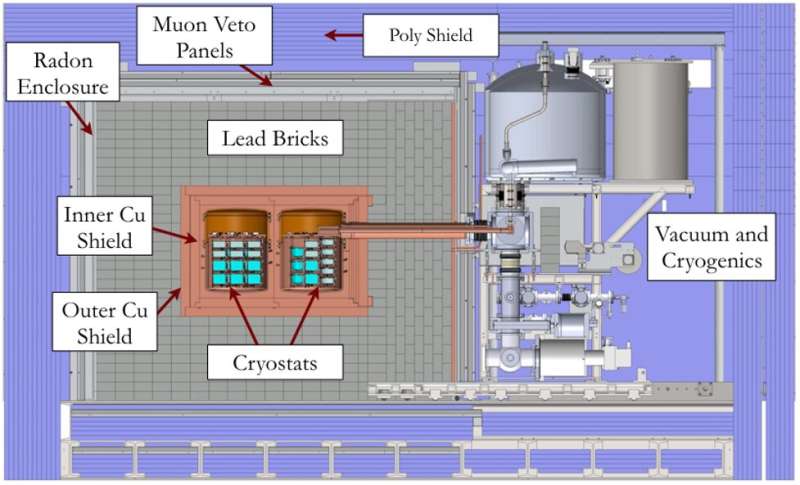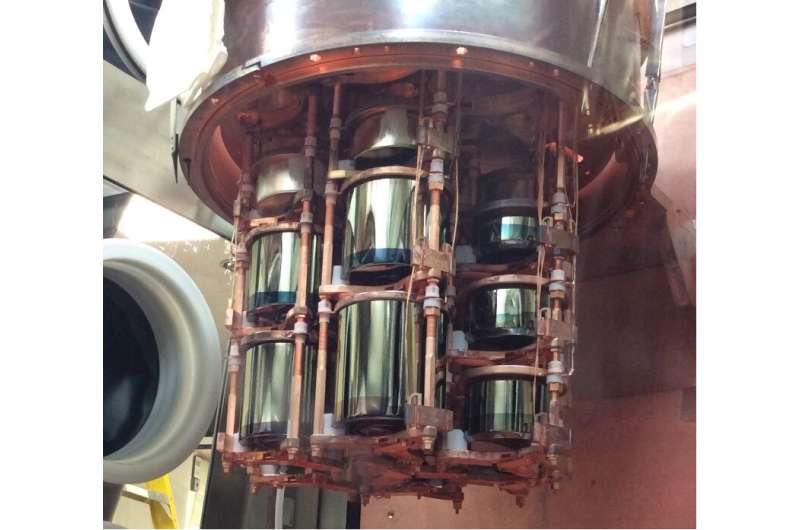March 2, 2023 feature
This article has been reviewed according to Science X's editorial process and policies. Editors have highlighted the following attributes while ensuring the content's credibility:
fact-checked
peer-reviewed publication
trusted source
proofread
The final results of the Majorana collaboration's search for neutrinoless double-beta decay

For more than half a decade, the Majorana Collaboration, a large consortium of researchers from different universities worldwide, have been trying to observe neutrinoless double-beta decay, one of the rarest forms of radioactive decay. This was done using the Majorana Demonstrator, a detector located at the Sanford Underground Research Facility in South Dakota, a laboratory that is almost 1 mile underground.
This large-scale experiment employed 30 kg of pure germanium (Ge) crystals, enclosed in deep-freeze cryostat modules and protected by the laboratory's outer protective lead shield. Its final results, published in a recent paper published in PRL, set new constraints on the neutrinoless double-beta decay (0νββ) of 76Ge.
"The primary objective of this 30-kg experiment was to establish the feasibility for a much larger experiment using germanium (Ge) detectors for neutrinoless double beta decay (0νββ)," Steve Elliott, one of the researchers who carried out the study, told Phys.org. "Previous work had demonstrated the viability of using Ge detectors for this research. This project was funded by the DOE and NSF after concepts were established using Laboratory Directed Research and Development (LDRD) funds from a number of national laboratories."
Neutrinoless double beta decay (0νββ) is a predicted form of radioactive decay that, if it exists, would require special characteristics of neutrinos, including having a mass and a Majorana nature. While neutrinos have already been found to have a mass, the experimental observation of this decay would ultimately also prove that they are Majorana particles, which essentially means that they also act as their own antiparticles.
"If the neutrino is a Majorana particle, it leads to theories that can motivate the preponderance of matter over anti-matter in the universe—a necessary condition for life as we know it to exist," Elliott explained. "This decay, if it exists, would be extremely rare with its half-life being longer than 1026 years (1016 times longer than the age of the universe). Being so rare, any other radiation, from trace impurities in the shield or from cosmic rays, depositing energy in the Ge would mask the signal."

The Majorana Demonstrator, the experimental set-up that Elliott and the rest of the collaboration used to search for 0νββ decay, is essentially a large collection of Ge crystals. These crystals, located at the Sanford Underground Lab, are operated as radiation detectors (i.e., instruments that can detect particles emitted during radioactive decay).
"The Ge material comprising these detectors is enriched in the isotope 76 to about 88%, whereas its natural abundance is about 7.75%," Elliott said. "These detectors are contained within an ultra-low radioactivity shield and sited deep underground to reduce sources of energy deposit giving rise to background to the signal from 0νββ."
The final Majorana Demonstrator results published in PRL bring the physics community once step closer to answering some crucial questions about the Universe and the matter it is comprised of. While they did not yet detect 0νββ decay, the Majorana collaboration's efforts demonstrate the feasibility of deploying their approach on a much larger scale to search for this elusive form of radioactive decay.
"The Majorana Demonstrator showed that a large array of Ge detectors with world leading energy resolution could be fabricated and operated in a radioactivity environment low enough to justify constructing a much larger project," Elliott said. "Even this small experiment was able to compete with much larger 0νββ experiments due to its low background and excellent energy resolution."
The Majorana collaboration has now joined forces with another research consortium, the GERDA collaboration, who built a similar detection experiment in the Laboratori Nazionali del Gran Sasso (LNGS) in Italy. Together, they constructed the LEGEND-200 experiment, a common effort aimed at detecting 0νββ decay for which they just recently started collecting data in Italy.
"We are proposing an experiment with 1,000 kg of Ge that is working through the DOE review process," Elliott added.
The research is published in the journal Physical Review Letters.
More information: I. J. Arnquist et al, Final Result of the Majorana Demonstrator's Search for Neutrinoless Double- β Decay in Ge76, Physical Review Letters (2023). DOI: 10.1103/PhysRevLett.130.062501
Journal information: Physical Review Letters
© 2023 Science X Network





















